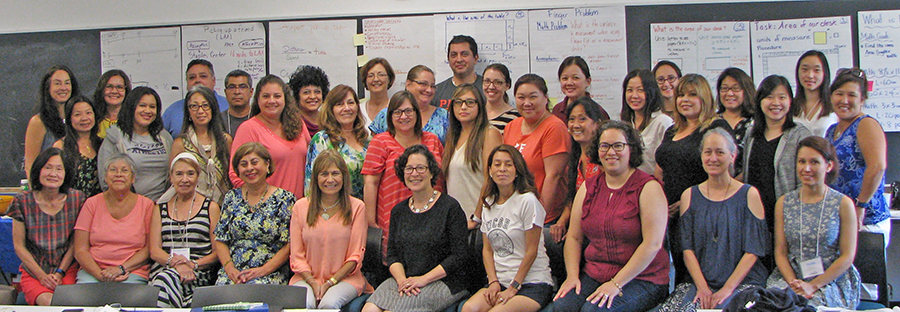Teachers Prepared to Inspire with Math Modeling
July 30, 2018
Give two kindergartners 10 apples and ask them to divide the fruit between themselves.
They may divide the apples equally with each getting five. Or, maybe one child is hungry, so that child gets more. Or, they may each take one and save the remaining eight to share with family and friends.
One of the key lessons learned by K–6 teachers participating in Harvey Mudd College’s IMMERSION program (Integrating Mathematical Modeling, Experiential-learning and Research through a Sustainable Infrastructure and an Online Network) is that there is seldom just one answer; the diversity of answers depends on the students themselves and how they decide to approach the problem.
For the past four summers, the College has been hosting cohorts of 24 teachers from the Pomona Unified School District (PUSD) for a weeklong professional development program. It’s part of a ground-breaking national study to examine how intensive training can affect elementary school teachers’ use of mathematical modeling in the classroom. The study was funded by a $1.3 million grant from the National Science Foundation.
With mathematical modeling—the process of taking an open-ended, multifaceted situation, often from life or the workplace, and using math to solve it—teachers can involve students in every step of the process, from formulating questions designed to resolve a problem relevant to students’ personal lives or communities to deciding what tools to use and what assumptions to make in order to find the solution(s).
“Everyone can do mathematical modeling from the earliest ages in the same way that everyone can start learning a language from the earliest ages,” said Rachel Levy, a former Harvey Mudd College (HMC) professor of mathematics who is overseeing the IMMERSION study along with colleagues at George Mason University and Montana State University.
Several teachers attending the IMMERSION program at HMC this summer, shared that their students were more confident in their math skills, more engaged, had a better grasp of math vocabulary and worked better in groups. Teachers here and at the other program sites cited positive results across a broad spectrum of abilities, including special education and advanced students as well as those with limited English proficiency and the economically disadvantaged.
Laura Pahler, one of five lead teachers participating at the Claremont site this summer, said mathematical modeling provides opportunities to use the existing math curriculum as a starting point and then go in a different direction.
“Instead of limiting students to word problems that may not be relevant to them and they don’t have any interest in solving, they can see problems in the community that math can help address and find a solution,” Pahler said. “You can get ideas from the textbook but adapt it. It’s the same math, you’re just changing the context to make it relevant to them.”
In addition to intensive professional development training during the summer, IMMERSION participants meet regularly in groups during the school year to collaborate with returning IMMERSION participants who serve as lead teachers then come together in late fall to participate in a conference at Harvey Mudd.
Marka Carson, another lead teacher, said her students begin to see math as useful in real-world applications.
“They learn that math is not this thing you do in isolation in the classroom and something to endure until math period is over,” Carson said. “It’s a skill we use in our personal lives and in the professional realm.”
PUSD has agreed to incorporate mathematical modeling training as part of its annual summer institute in an effort to ensure that all students experience mathematical modeling throughout their K–12 education. From the start of the program, PUSD and HMC administrators have closely cooperated to make the effort a success. “Without the support of Lilia Fuentes and Grace Greenleaf at PUSD and Gabriela Gamiz, director of community engagement at HMC, this program could not have succeeded,” said Levy.
Several lead teachers are writing up their findings from the IMMERSION experience, including chapters on how to use mathematical modeling in kindergarten and what students are doing when they are modeling. The PUSD teachers have presented their work at national mathematics and mathematics education conferences and have been invited to lead professional development for other teachers. They are also developing a handbook about mathematical modeling for PUSD school principals.
Levy, who is now deputy executive director of the Mathematical Association of America (MAA) in Washington, D.C., is working with the teachers and will return next summer to work with the district.
“The mission of the MAA is to advance the understanding of mathematics and its impact on the world,” Levy said. “That’s exactly what mathematical modeling is about. Mathematical modeling helps students make connections between mathematics and the world.”
